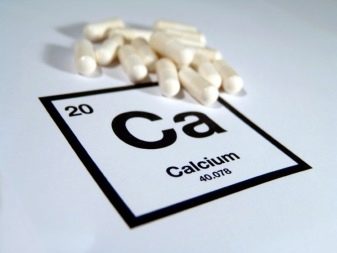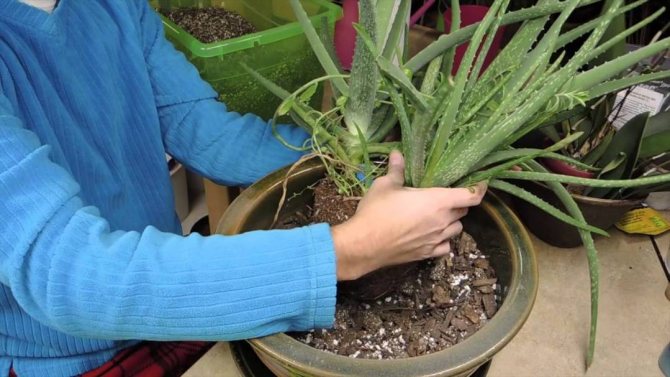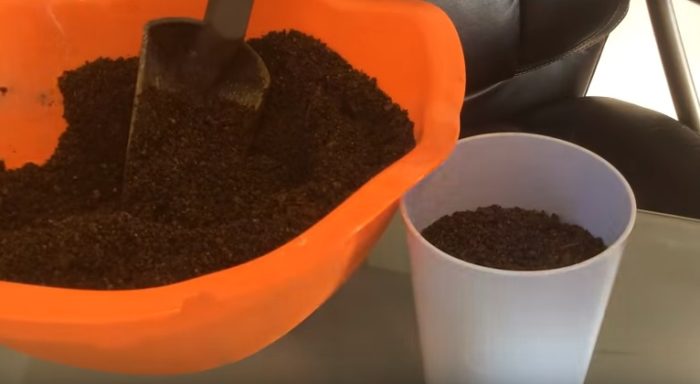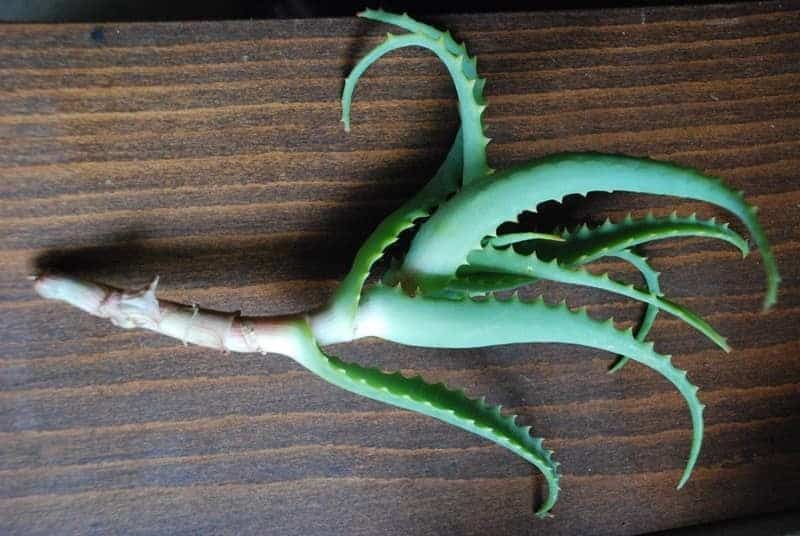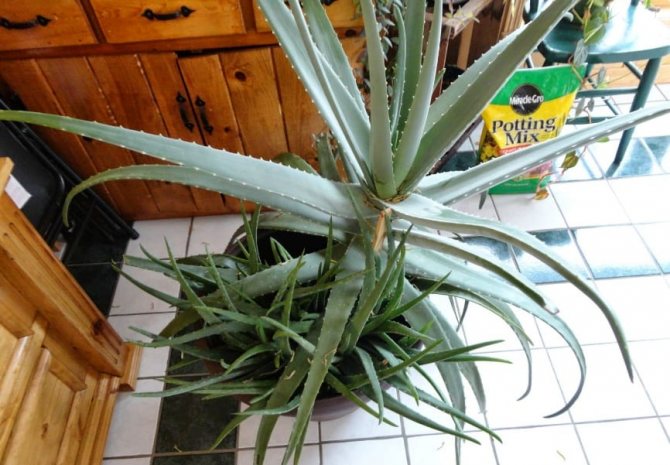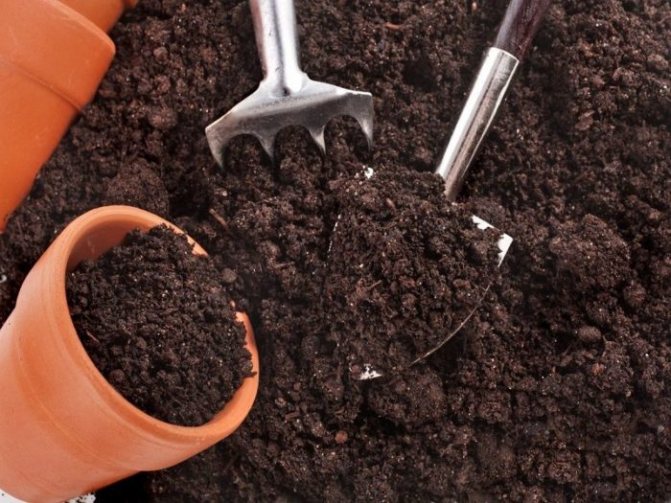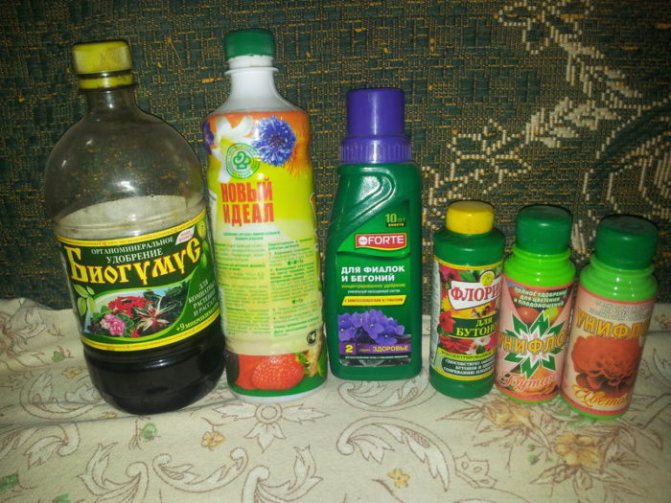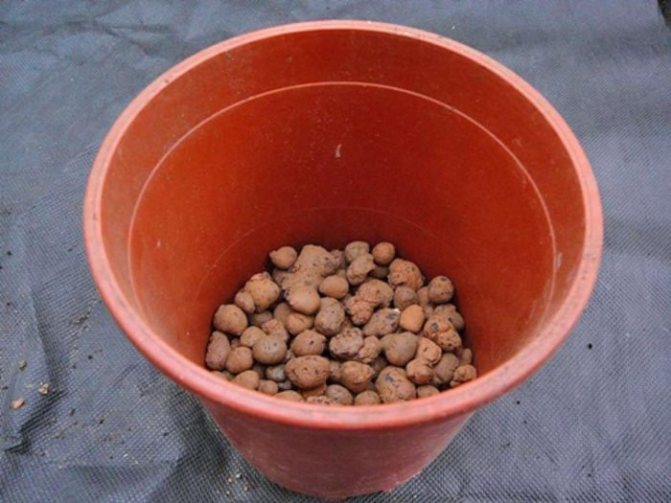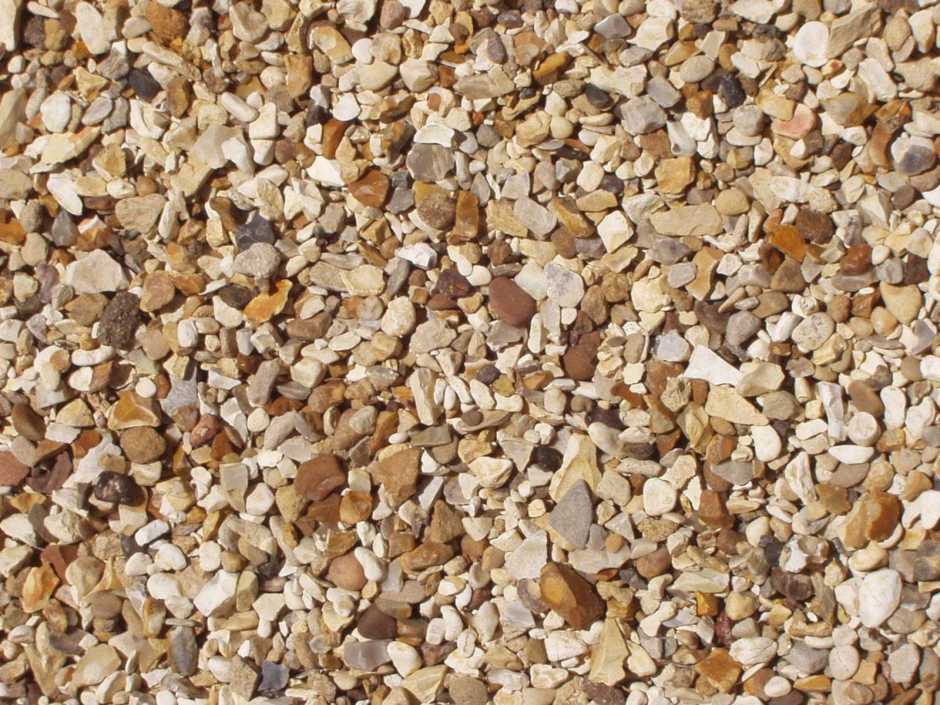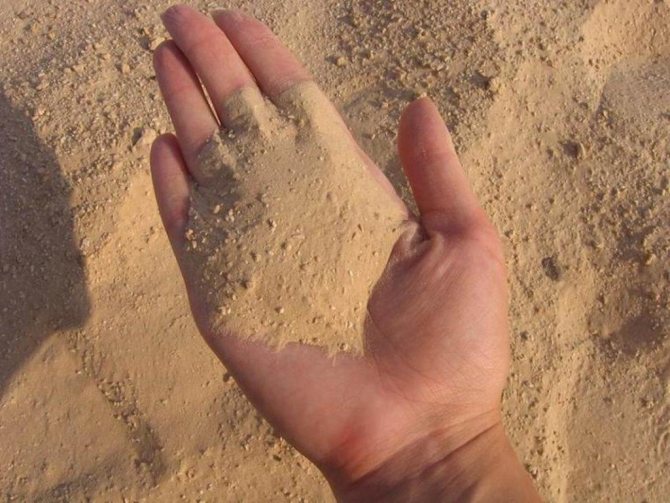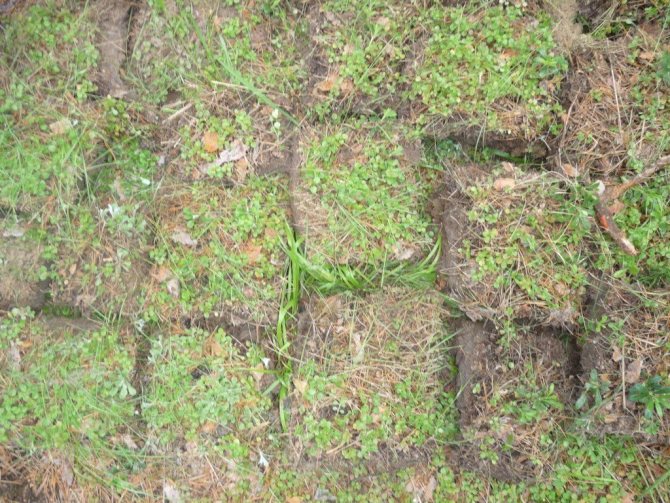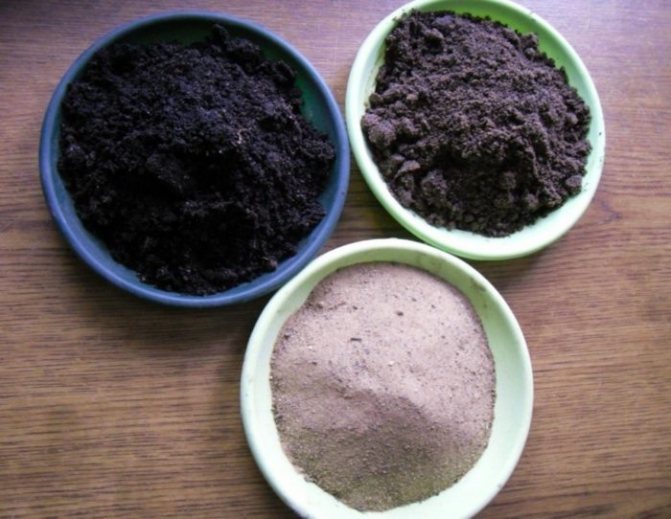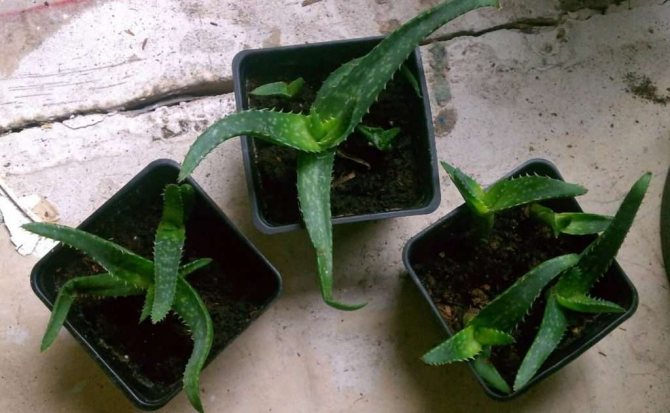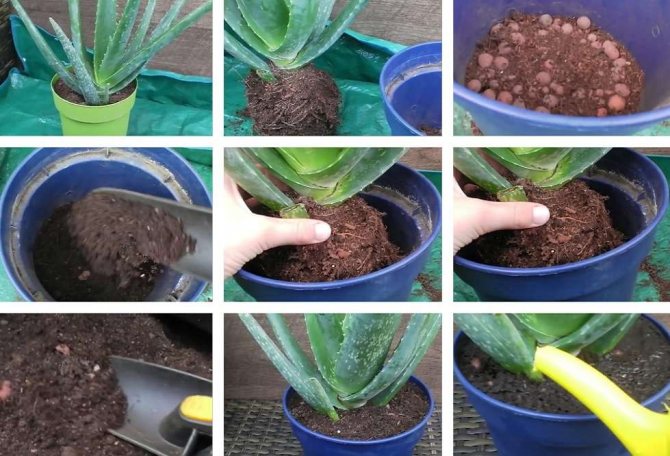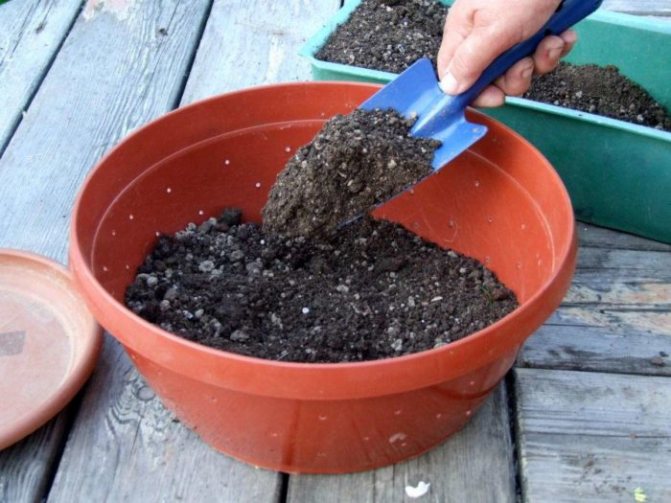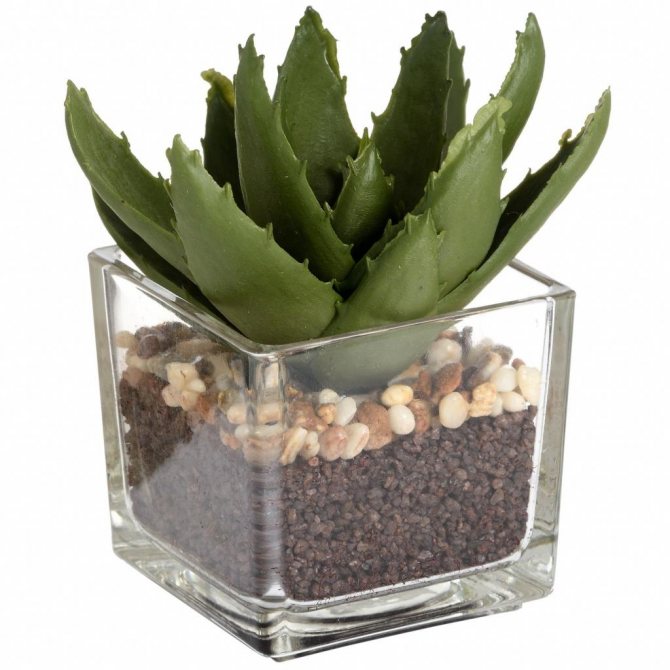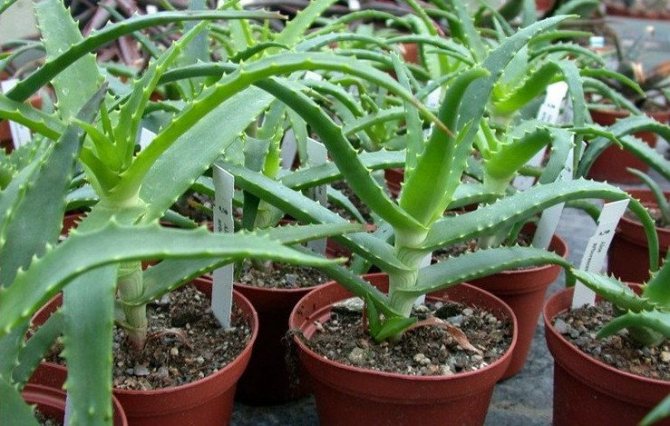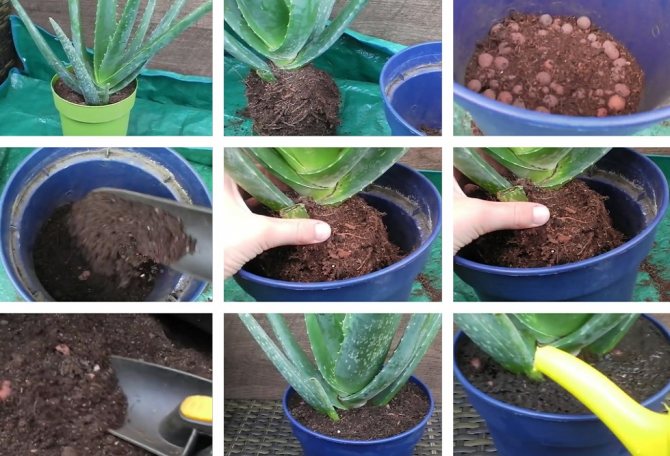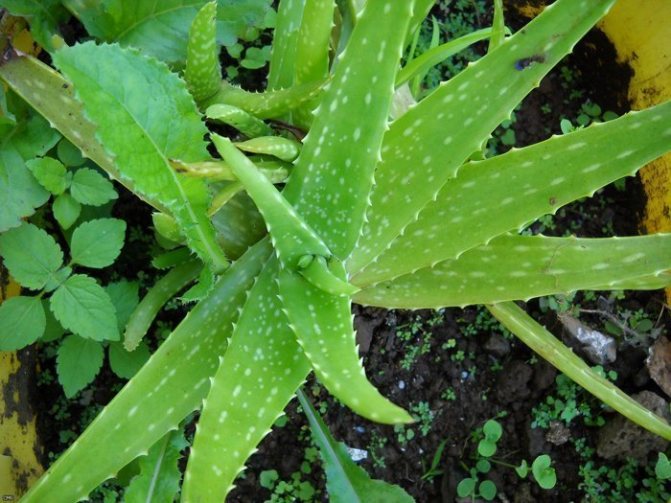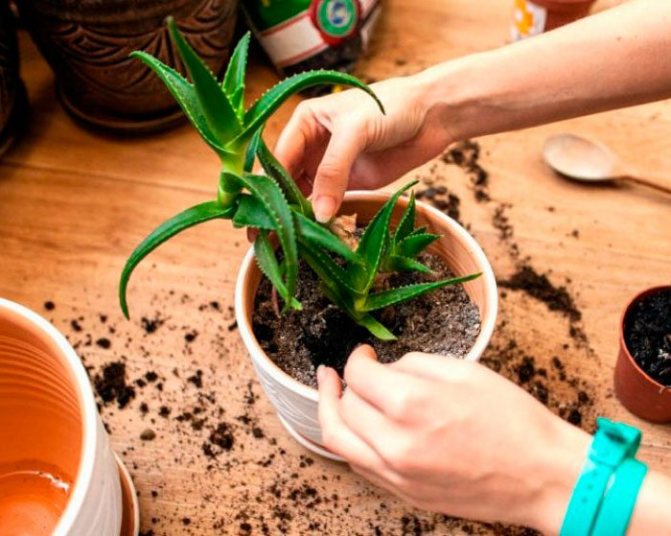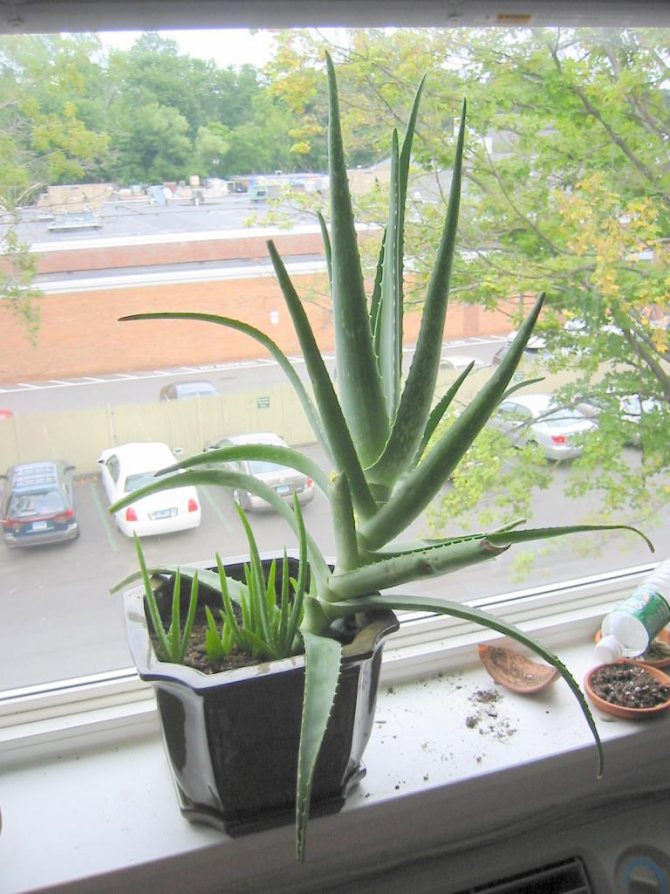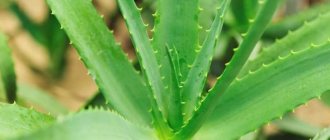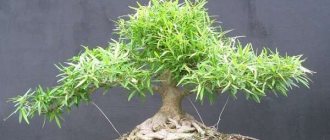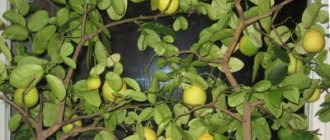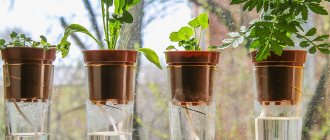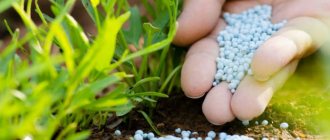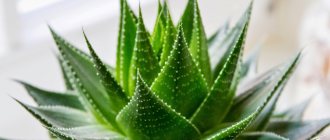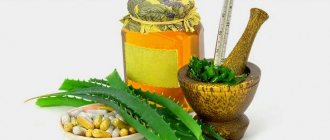Posted in Succulents, Care Published 06/21/2018 · Comments: · Read: 4 min · Views: 1 269
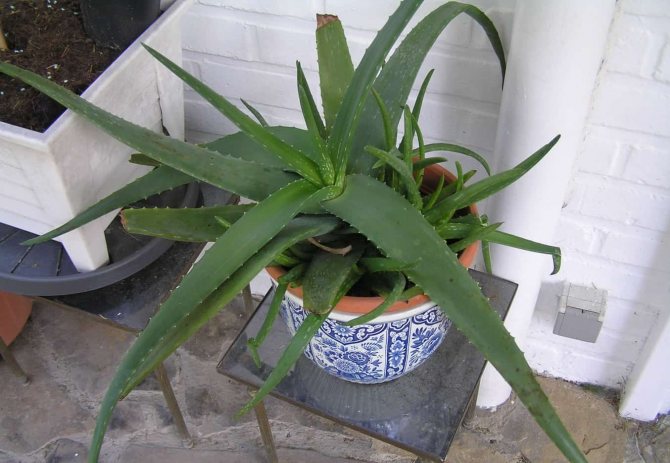
Aloe is one of the most common succulents. Caring for him is not particularly difficult. The main thing is to divide and transplant the overgrown plant in time. Despite the seeming simplicity of the transfer work, they must be carried out in compliance with certain rules. How to properly transplant aloe at home will be discussed below.
How to plant aloe properly at home
This plant belongs to the category of succulents. Therefore, aloe prefers well-lit window sills and easily tolerates a lack of moisture, since it accumulates in its leaves with rare watering. Subject to the basic requirements of the culture, this plant will not cause trouble.
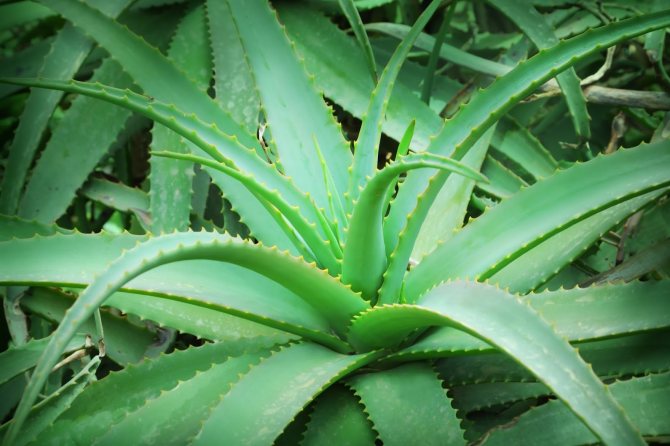

Aloe is considered to be a home healer
Note! For its full development, it is important to properly plant. This procedure includes several main stages. Therefore, it is worth familiarizing yourself with them in advance.
What time of year is it better to plant and is it possible in winter
Planting aloe, like other indoor plants, is best in late February - early March. It is during this period that the plant leaves the state of winter dormancy and biological processes intensify in it.
If during this period it was not possible to land, then the procedure can be postponed until the end of summer, namely until July-August. At this time, sap flow in the tissues of the plant increases, so it easily tolerates planting and quickly recovers
Important! Planting aloe in late autumn, as well as at the beginning and in the middle of winter, is not recommended, since at this time the plant is in a dormant stage and will not be able to fully root, which means it will die.
What land is needed for aloe
In nature, this plant can be found in countries with arid climates and nutrient-poor soil. At the same time, aloe feels great in such conditions and grows well. Therefore, it is necessary to prepare a soil for him, the composition of which will be as close as possible to the natural habitat.
You can buy a ready-made substrate in a flower shop, choosing a soil mixture for cacti and succulents. But you can also prepare a suitable soil for aloe yourself. The main thing is that the substrate is loose, light and well-drained.
To plant aloe, you need to mix the following components:
- turf - 40%;
- leafy soil - 20%;
- coarse sand - 20%;
- small pebbles - 10%;
- charcoal - 10%.
Important! Peat should not be added to the soil, as it increases acidity, and this has a depressing effect on the roots of the plant.
Soil for aloe should not be nutritious, the main thing is that moisture does not stagnate in it.
In what container is aloe grown: the size of the pot
The root system of aloe, like all succulents, is small, but the leaves are fleshy and large, since they contain a supply of moisture and nutrients. Therefore, for the plant, it is necessary to select not too deep, but wide pots. When planted in high containers, the plant will constantly turn over.


The diameter of the pot must be selected depending on the age of the seedling
At the initial stage of growth, the width of the planting container should be within the range of 8-9 cm.With subsequent transplants, it can be increased by 2-3 cm.
For your information! You cannot immediately plant aloe in too large a container, as the excess soil in the pot will begin to acidify and provoke root rot.
A place
A regular window sill located in the south or east of the house is good for growing aloe (the north side is a bad option). It should be well lit, but exposure to the open sun is undesirable. Create a small partial shade - and the plant will thank you for the good care.
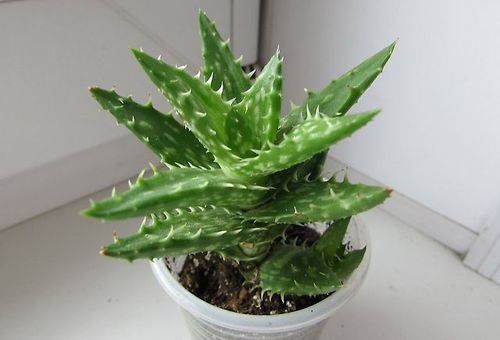

Use a plastic or terracotta pot as a container for planting a flower. These materials do not allow moisture to pass through well, which is good for the plant. The size of the planting container should be such that the root system feels spacious (there should be a 3 cm gap between the walls and the root). Choose a pot with a shallow depth.
Advice! To determine if there is enough space for the plant to stay comfortably, be guided by the ratio of the length of the leaf to the diameter of the planting dishes: a 2: 1 ratio is ideal.
How to properly plant aloe in a pot
Before you start planting, you need to prepare everything in advance so that during the procedure everything is at hand. This will require:
- pot;
- priming;
- drainage;
- settled water at room temperature;
- Activated carbon;
- sharp knife.
How to plant an ampelous petunia correctly
When everything is ready, you can proceed directly to planting aloe. At the same time, it is important to follow the procedure and strictly adhere to the recommendations.
Landing Algorithm:
- Inspect the root of the seedling and, if necessary, remove damaged and rotten areas with a knife.
- Sprinkle the slices with activated charcoal.
- Lay drainage at the bottom of the pot with a layer of 1.5-2 cm.
- Sprinkle it with substrate on top.
- Place the seedling in the center of the pot, straighten the roots gently so as not to damage them.
- Fill the resulting voids with earth, slightly compact the surface.
- Water the plant abundantly and place in a slightly shaded place for rooting.
Note! When planting, the root collar of the aloe should be at or slightly above the soil surface, which will eliminate the likelihood of stem decay.
As soon as the seedling grows, it must be placed on a sunny windowsill. In the future, it is necessary to water the planted plant as the top layer of the soil dries out.
Role of soil
Succulent is able not only to decorate the interior, but also to help in the fight against a cold, acne and skin aging. The rich vitamin and mineral composition of aloe allows you to use it for the preparation of masks, lotions and ointments. However, all these healing properties will only be effective with proper care and nutrition. If the plant develops safely and receives enough nutrients, it is capable of evaporating phytoncides, disinfecting the air in the room and activating the protective functions of the human body... Caring for an indoor succulent is a simple matter, following simple rules you can get a strong and beautiful plant with a rich chemical composition.
Signs of a healthy plant - elastic leaves of a bright green color, the absence of twisted and dried tips. If you notice that even with proper care, your plant does not feel well, then it needs to be transplanted into a different soil.
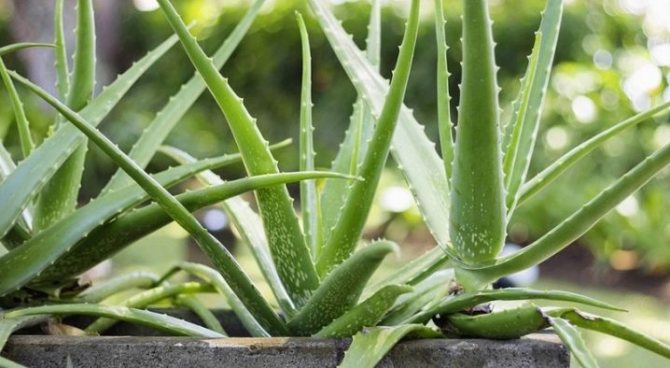

How to grow an aloe from a scion without roots
Sometimes the question arises, how to plant an aloe, if the shoot is without a root. In this case, it is quite possible to grow a plant if you act correctly.
Chinese schisandra - how to plant correctly
This situation can arise in the following cases:
- had to disconnect the lateral process;
- the bush requires rejuvenation;
- the roots of the plant have rotted, but the top has survived.
Important! Since the aloe is a succulent, it is not recommended to root the shoot in water, as it can rot, so it is better to immediately plant it in the soil.
Are there any chances of success
Before planting the cuttings without roots, you need to refresh the cut and leave it to dry for 2-3 days in a shaded place. During this time, a kind of film is formed, which protects against the penetration of infection into the plant tissues and prevents excessive evaporation of moisture.
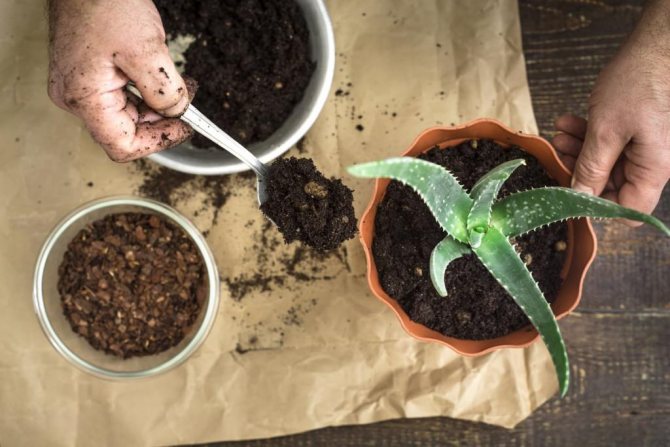

The rooting of the shoot takes place within 3-4 weeks.
In the meantime, it is necessary to prepare a special soil for the aloe sprout. In this case, you need to mix sod soil and river sand in a ratio of 1: 2. Bake it in the oven for 15 minutes. at a temperature of 100 ° C to disinfect.
To plant the appendix, you can use a plastic cup, making drainage holes in it, lay expanded clay on the bottom with a layer of 2 cm, and fill the remaining 2/3 of the volume with the prepared substrate and moisten it. After that, plant the shoot, deepening into the soil until the first pair of leaves. Then compact the soil at the base, and sprinkle the surface with small pebbles. This will strengthen the seedling and prevent it from falling.
For full-fledged rooting, it is necessary to rearrange the container with the handle to a bright place with a temperature of 23-25 ° C, while the plant should not be exposed to direct sunlight. Periodically, it is necessary to moisten the soil, observing the rule - it is better to underfill than overflow.
If the whole procedure was carried out correctly, then the process will take root without any problems. You can determine this by the new leaves that begin to appear at the top.
For your information! A month after rooting, the shoot must be transplanted into a suitable soil and pot.
Landing
Chubuki, apical shoots, leaves after drying are planted in a previously prepared soil. They do it like this: the planting material is placed in moist ground down with a cut to a depth of 2-3 cm.Then it is covered with a glass jar or cellophane to create a greenhouse microclimate. The pot with seedlings is kept in a bright, but protected from direct sunlight place. When selecting shoots, preference should be given to those with 5-6 leaves. The stems are immersed in the ground to the point of growth of the lower cotyledon. To keep the shoot stable, small pebbles are laid around it. Then they equip a mini-plate, not forgetting to irrigate the soil occasionally. "Children" are sent to a new place of growth with existing roots. If, separating the root branch, you damaged the root, then it is necessary to dry it for several days before planting in the ground. Intact specimens are planted immediately.
How to grow aloe from a leaf
This method of growing an aloe vera seedling or other crop at home is more labor intensive.
Money Tree - how to plant it correctly so that money is kept
For rooting, it is necessary to use the lower leaves from a plant over 3 years old. They should be fully developed and with good turgor. The leaves must be cut off with a sharp knife at the base and put to form a protective film for 2-3 days in a shaded dry place.
Rooting should be carried out in clean sand, which should be calcined in the oven beforehand. For planting, you need to choose wide bowls with drainage holes to drain excess water. It is necessary to fill them with prepared sand and moisten it evenly. Leaves need to be deepened into the sand by 3 cm, put the container with seedlings in a warm, bright place with an air temperature of 23-25 ° C.
Important! To grow aloe from a leaf, as well as from a scion, it is not necessary to create a greenhouse effect during rooting, as this leads to decay.
If all the recommendations are followed, after 1.5-2 months, small sprouts should appear at the base of the leaves. Throughout this period, the sand in the container must be kept slightly moist.
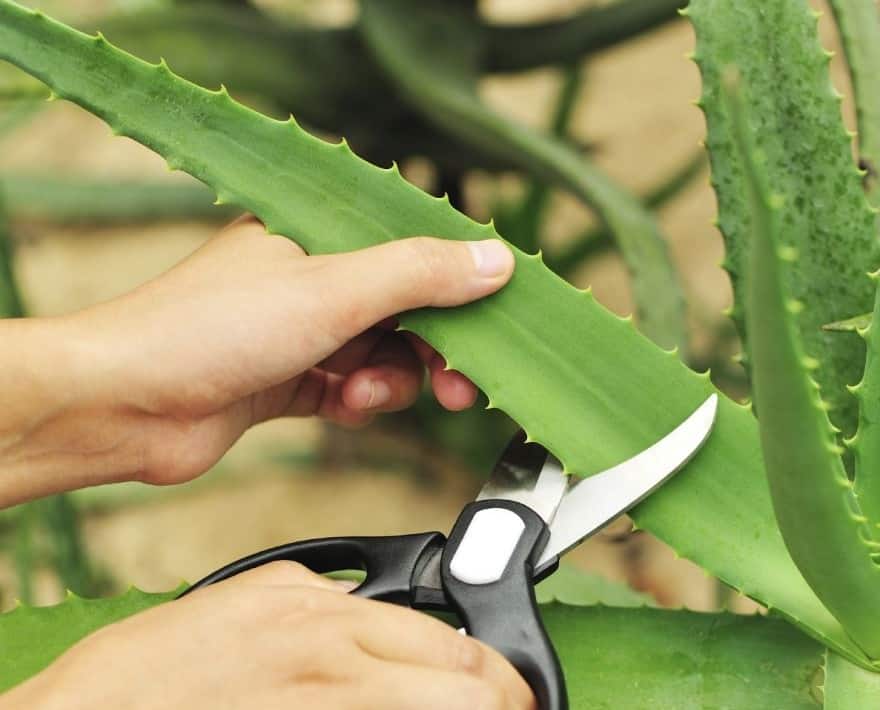

Leaf propagation takes patience
It is necessary to plant young seedlings in separate containers when their leaves grow up to 3-5 cm. In this case, you need to take a full-fledged substrate as for adult plants.
Knowing how to grow aloe from a leaf, you can get a large amount of planting material. This method of reproduction allows you to preserve all the specific qualities of the mother plant, which cannot be achieved if seedlings are germinated from seeds.
Selection of soil and pot
Before transplanting aloe at home, you need to take care of purchasing a suitable pot and making the right potting mix. Like any other succulent, this plant needs a medium-nutritious potting mix. It can be prepared by mixing equal parts of clean river sand, leaf humus and turf. You can also purchase a specialized soil designed for growing succulents.
The root system of aloe is well developed, so the pot for transplanting it should be deep and wide enough. When choosing, preference should be given to plastic containers. They retain soil moisture longer and are much easier to wash and disinfect.
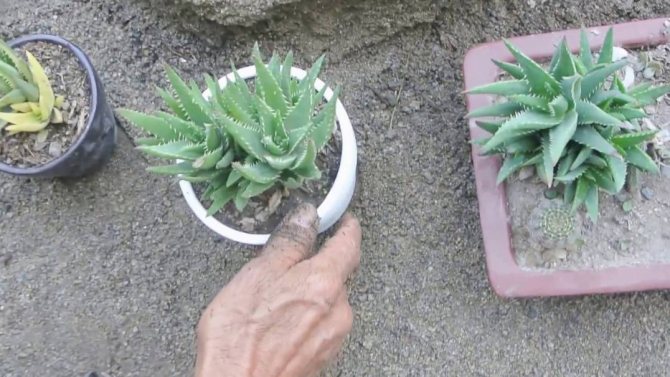

Caring for aloe at home after planting
The planted plant needs quality care. Any mistake of the grower at this stage of growing aloe can become disastrous, since the plant has not yet had time to get stronger. Therefore, you should pay attention to the basic requirements of culture, which cannot be ignored.
Care rules:
- lighting. Aloe is considered a light-loving plant, therefore, it is necessary to select a southern or eastern window sill for it. But at the same time it is necessary to exclude direct sunlight, as they can cause burns on the leaves. In winter, this houseplant needs additional artificial lighting. The lamps should be placed at a height of 35 cm above the plant;
- content temperature. This succulent thrives at high air temperatures. In the summer, a flowerpot with a flower can be put out on the street. In winter, when the aloe is at rest, the favorable temperature is 16 ° C;
- humidity. Aloe is a drought-resistant plant, so the leaves should not be sprayed. The optimum humidity level is 60-65%. Sometimes you can simply wipe the leaves to remove dust;
- transfer. This procedure should be carried out when the succulent pot becomes cramped. In this case, the plant stops actively growing, and young leaves become significantly smaller. The transplant is recommended to be carried out by the transshipment method, without destroying the earthen clod at the roots.
How to feed aloe
This plant does not need a high nutrient content. For feeding, you should use mineral fertilizers, which can be purchased at the store marked "for succulents".
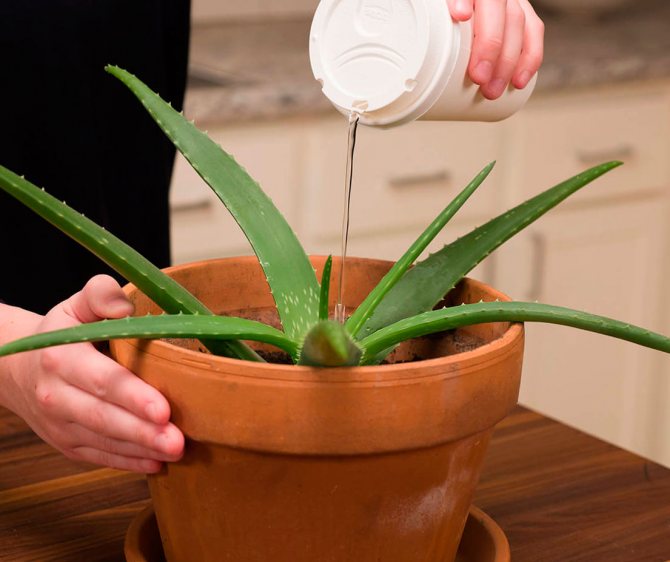

Fertilizing aloe is rarely necessary.
Features of top dressing:
- when planting in a purchased substrate, fertilizer should be applied for the first time only after six months, and in other cases - after 3 months;
- the indicated dosage in the instructions cannot be exceeded;
- it is necessary to use fertilizers from March to the end of September 1 time per month, and take a break in late autumn and winter;
- only healthy seedlings can be fed.
Important! It is impossible to use aloe for medicinal purposes after feeding, in this case you need to stand it for 2 months.
How to water properly so as not to ruin a young plant
Aloe does not tolerate waterlogging of the soil. Therefore, it is necessary to water the plant only when necessary when the top layer of the soil dries out, avoiding stagnation of moisture. It is also important to periodically loosen the soil in the pot to improve its breathability.
For humidification, it is recommended to use settled water at room temperature.Watering should be carried out at the root so that water does not get on the leaves. But it is also acceptable to sometimes pour water into the pan to saturate the substrate with moisture.
Choosing aloe as a houseplant, planting and care at home will not cause serious difficulties. Therefore, any florist, regardless of his experience, can cope with this task.
Watering


It is rarely irrigated, because the agave has the ability to live a long time without moisture: in spring and summer every week, and in cold weather it is enough to carry out this procedure twice a month. Abundant moisture should be avoided, since excess water in the container provokes rotting of the root system.
To prevent this, a drainage layer is arranged in a pot with holes for the drainage of excess moisture. Water for irrigation should be warm - +25 - +35 degrees C. There is a replacement for this procedure. A container with aloe can be placed in a tray with water, the soil and roots are saturated with moisture through the holes in the bottom of the pot.
Potential problems during and immediately after boarding
Often, planting and reproduction of aloe goes without any difficulties. But sometimes flower growers complain that this succulent does not take root. Therefore, you should find out why this is happening.
The most common cause of plant death is excessive soil moisture, which is associated with improper watering. To correct the situation, it is necessary to remove the plant from the pot, clean the rotten areas and roots with a knife. After that, sprinkle fresh wounds with charcoal and dry for several days in a dark place.
Then plant in an equal proportion of sand and turf. Do not water the plant for the next 2 weeks. If during this time the decay process does not resume, then the soil in the pot can be slightly moistened. As soon as the plant fully grows stronger and grows, it must be transplanted into a full-fledged substrate.
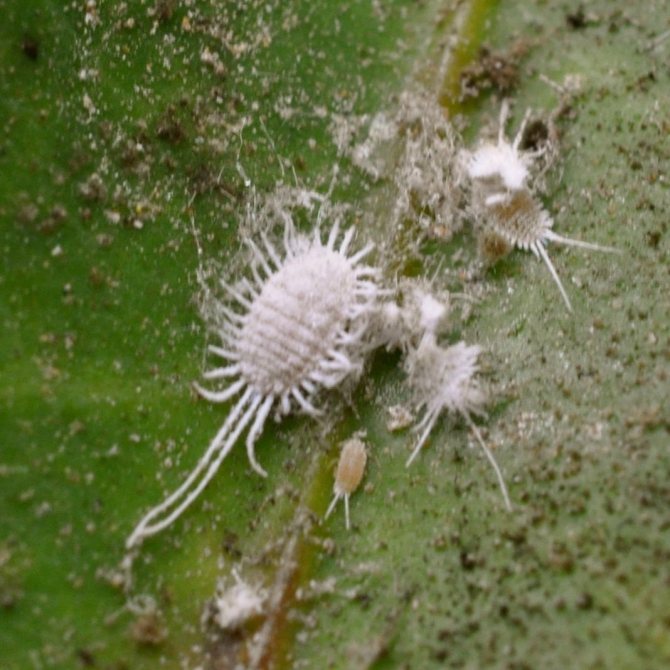

Mealybug - a dangerous pest of succulents
Another reason that aloe does not take root may be a mealybug. This pest lays eggs in the roots of the plant. As a result, the larvae that appear feed on the sap of the plant, which prevents rooting. In this case, it is recommended to water the plant with a solution of the Aktara preparation (1.4 g per 6 L). After a week, spray the plant and soil in the pot with phytoverm.
Note! Treatments must be carried out until the pest is completely destroyed, alternating preparations.
What to do if it does not take root
If, despite all the efforts spent, the aloe still cannot fully take root, you need to check if all the recommendations are followed. When planting and growing, everything matters, so even the smallest details should not be ignored.
Most often, the plant cannot fully take root, since the temperature regime is not observed during the rooting period. In this case, it is recommended to repeat the planting, while completely replacing the soil. You should also wash the pot well and scald it with boiling water.
Growing aloe, like other succulents, is not difficult, the main thing is to provide the plant with conditions that are as close as possible to its requirements. First of all, this concerns planting, since development in the future depends on it. Otherwise, even an inexperienced grower can cope with caring for aloe.
Reproduction using cuttings, stems, leaves
All these methods are similar to each other. To reproduce each of them, you will need to complete the following steps:
- Select a suitable plant fragment and cut it off, the knife must be sharply sharpened and well washed,
- The cut site must be well dried. The cut off part is stored for about a week in the open air in a dark place, after processing the cut with rubbed activated carbon.
- The shoot is cut from an adult plant with up to eight large leaves. After the cut site has dried, the Aloe fragment can be planted.
Advice! Do not immerse the leaf, shoot or stalk in a container of water before planting. This can destroy them, because the process of decay will begin.
If you have chosen the basal process for breeding a new individual (they are also called "babies"), then the best time to separate the process will be a planned transplant of an adult specimen. You will need a sharp knife to separate the "kids" from the root. Make sure that small roots also remain on the "kids" that you cut off.
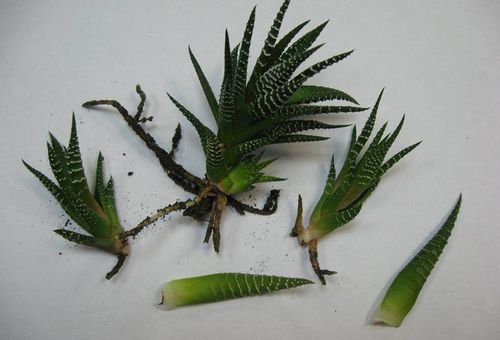

Reproduction using parts of an adult plant is usually carried out in the warm season.
Soil characteristics
The natural environment of a migrant from southern countries is an arid climate, an abundance of sunshine, high air temperatures and minimal rainfall. As a result, the soil is poor in composition and moisture content, namely: sandy, stony or clayey. These are the main characteristics that should be followed when choosing a soil for aloe. In heavy fertile soil, the roots of the succulent will rot, and in the absence of air circulation, the leaves will begin to turn yellow and dry out, which is detrimental to the plant. It is important to provide high-quality drainage, for example, the soil should be sufficiently loose and free-flowing - this will allow oxygen to penetrate unhindered to the roots and help to avoid moisture stagnation.
So, the soil for aloe should have a number of the following characteristics:
- have a light and loose structure;
- contain natural leavening agents;
- do not retain excess moisture for the plant;
- promote the penetration of air to the roots.
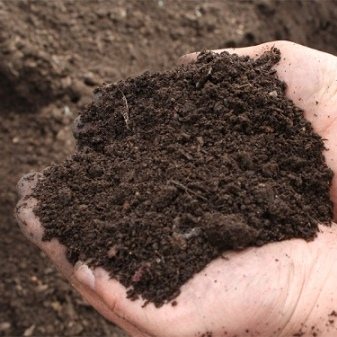

Photo of a houseplant
Below are photos of indoor Aloe Vera that has been properly cared for:
What is the benefit
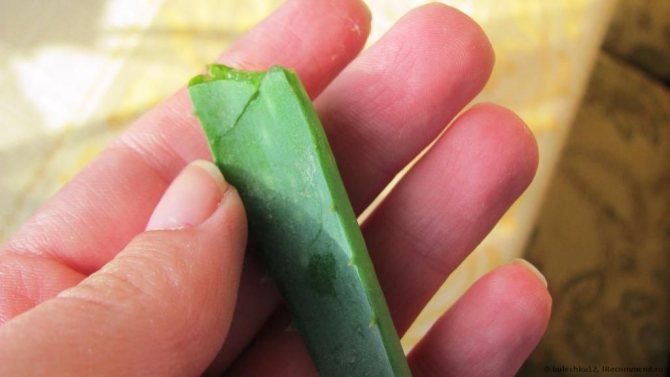

The liquid released from the leaves of aloe is a so-called gel that can heal not only superficial wounds, but it also greatly accelerates the body's recovery process after an ulcer. In addition, the healer is able to reduce pain, relieve inflammation, has an antimicrobial effect, and is able to remove burns. This plant, which has a bacteriostatic effect, is able to fight staphylococcus, all kinds of pathogens of diphtheria, fights dysentery, and has a detrimental effect on fungi.
Temperature conditions for growing aloe
The most comfortable temperature for aloe in the summer is 22-26 ° C. Air humidity for a plant does not really matter. The plant can overwinter at a temperature of 13-15 ° C, but it is very important to avoid drafts during this period, otherwise the aloe can simply freeze.
Fresh articles about garden and vegetable garden
Eucharis leaves turn yellow and die
Flowers for the school office
Peach shelter for the winter
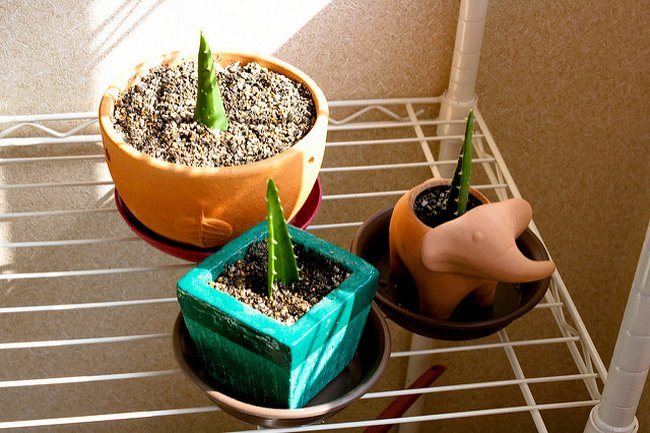

The right choice of a new flowerpot
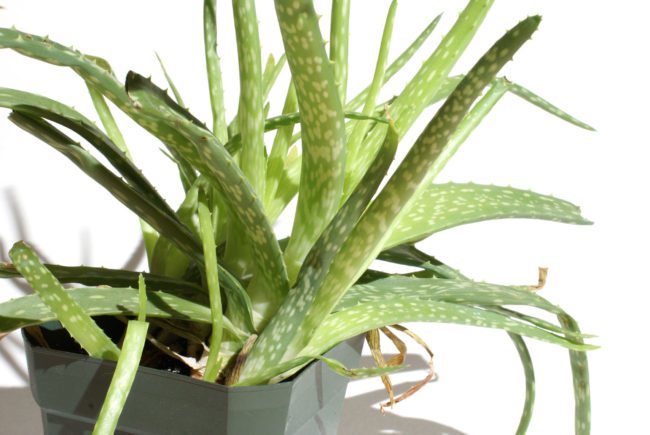

Aloe transplant should be approached as carefully as any other green windowsill dweller. The size of the new pot depends on the reason for replanting. A larger container is needed for a young plant with a strong root system. A plant that has released daughter shoots can be left in the same pot if all the shoots are removed. The procedure for rejuvenating aged aloe with a lodged stem requires a flowerpot of the same or slightly smaller volume. Small containers will be required for planting budding babies. All flowerpots, regardless of their volume, size and material, must have drainage holes on the bottom. Aloe does not tolerate soil acidification. Previously used pots must be washed and disinfected.
Which pot to choose?
If you are going to move the aloe to a new dish, you need to know the requirements for the size of the pot. If the dishes are too large, the soil leaches out, the roots rot, and the plant stops developing. Pay attention to the material from which the pot is made.
How to find the right size?
There are several ways to determine the optimal pot size.It should be such that between the roots in a straightened form and the walls, the bottom of the vessel there is 1–2 cm of free space.
Determine the required dimensions and crown. In a properly selected container, the diameter is 2 times less than the distance between the edges of the opposite leaves. The older the plant, the more powerful its root. Therefore, the pot is taken more every time.
Another way not to be mistaken with the choice is to compare the new and old containers. The diameter should increase by 3 cm.
Material selection
The pots are made from plastic and clay. Each material has its own pros and cons. Plastic products have the following advantages:
- lungs;
- do not beat when dropped;
- are inexpensive.
The advantage of a clay pot is that the water in it does not stagnate for a long time due to the porous structure of the walls. Thanks to this, the roots do not heat up and do not die even under the scorching sunlight. More weight gives stability, which is not possessed by a plastic analog.
Preparing the soil for aloe
Nothing spoils the life of an evergreen succulent like compacted soil or stagnant water. These two troubles make it very difficult for oxygen to reach the roots. Therefore, the earth must be airy: loose, water and breathable. As a ripper, the soil for aloe includes:
- river, coarse sand;
- gravel;
- brick chips;
- shell rock;
- perlite (volcanic rock).
It is possible to determine what kind of land is needed for aloe based on the following indicators:
- water-alkaline balance: neutral, slightly acidic;
- structure: loose, porous;
- composition: clay, turf, sand, humus.
If we look at the pot in section, we will see a "cake", the lower part of which is filled with drainage, the middle - with an earthen mixture, and the top is framed with gravel or coarse sand.
Regardless of the variety, in the earthen mixture for growing crops, the presence of sod or clay-sod land is required. The substrate consists mainly of the following components mixed in equal parts:
- clay-sod land;
- leafy land;
- sand.
The necessary composition of the soil for aloe is supplemented with neutral or slightly acidic peat and rippers. While not a universal formula, it works great for most crops.
The best utensils for planting plants are plastic or heavy terracotta. Unlike clay, it has no pores, so the walls of such pots do not evaporate moisture, but retain it. When choosing dishes, be guided by the size of the roots - they should fit freely, at a distance of about 3 cm from the walls. It is possible to determine the tightness of "housing" by the ratio of the length of the leaves to the diameter of the container, ideally it is equal to 2: 1.
The best place for them is window sills on the south or east side, the northern coldness has a negative effect on plants.
To preserve the healing qualities, pets need fresh air, provided that it is warm. That is, it is categorically not recommended to open the window for ventilation on a rainy November day. A portion of fresh air boosts plant immunity, reducing the risk of infection and weakening. They are removed from hibernation gradually, replacing watering with spraying. You can also put water next to the pot.
The flower is not picky about food: a weak solution of low-nitrogen fertilizer is quite enough for it. An excess of nitrogen leads to such developmental anomalies as a delay in flowering and the massive appearance of shoots.
The healing properties of aloe
The centenary is a real pharmacy on the windowsill. The properties of indoor aloe are well studied, there are many recipes using the healing juice of succulent leaves. The most useful properties are in mature plants that have crossed the three-year line. The fame of the healing aloe has reached our days since the colonization of Africa.
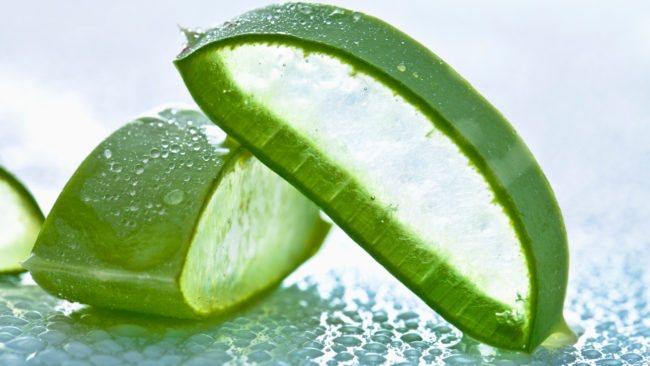

Aloe leaves contain a huge amount of useful substances: vitamin C, which strengthens the immune system, has a general rejuvenating effect on the body. And besides this: • carotenoids, synthesizing vitamin A in the body, normalizing cholesterol levels; • kakhetin, which strengthens the walls of blood vessels, neutralizes allergens; • flavonoids, which have a tonic effect and are indispensable for acclimatization; • tannins, which have a hemostatic and anti-inflammatory effect; • enzymes that have a beneficial effect on the digestive system and liver; • a complex of trace elements and minerals that increase immunity by cleansing the body of toxins and normalizing metabolism. Related articles: All about the timing of the flowering of the garden hydrangea Adenium Mini - what are the flowers How to choose the soil for the garden hydrangea Amazing euonymus: types and features
Why doesn't the plant take root?
Aloe is not a demanding plant, but mistakes in agricultural technology lead to problems.
When transplanting into another pot after purchase or, if necessary, inexperienced growers make a number of mistakes:
- They do not disinfect tools and soil.
- Do not process plant slices.
- Planting material with broken roots is planted.
- Sprouts or leaves are germinated in water.
- Place immediately under sunlight.
- Having failed to withstand the adaptation period, they begin intensive watering and feeding.
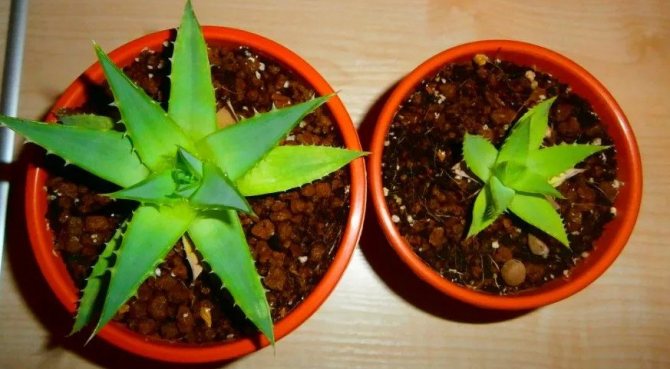

What points in cultivation need to be taken into account in order to avoid diseases:
- aloe loves sunlight, which must be uniform, otherwise the shoots will stretch out. The pot must be regularly rotated around its axis;
- the plant starts get sick if standing in a draft;
- excessive watering leads to root rot - need to be watered abundantly, but rarely. Be sure to drain excess water from the pallet;
- spraying is not carried out, you can only wipe the leaves with a damp cloth;
- water for irrigation should not be cold, chlorinated water must be defended;
- fresh organic matter destructive to the flower (manure, droppings);
- after the flower falls, the peduncles must be removed.
Having familiarized himself with the rules for growing and transplanting an agave, the gardener will be able to avoid problems with rooting and flower development. A healthy plant is not only pleasing to the eye, it can also be useful for medicinal purposes.
Using the top of the flower
Using the top of aloe for propagation injures the plant, but it is often used to rejuvenate an aged flower, and if its lower leaves and side shoots have already been cut off. This method is simple and easy to perform and leads to the rapid establishment of the apical process.
It is carried out as follows:
- the top must be cut off so that there are at least 7 leaves on it;
- the cut off top is dipped in a cut into a solution of phytohormone growth or other root growth stimulator and kept for 30 minutes;
- then the treated process is placed in a glass container with warm (but not hot) water;
- soon the first roots appear, and after they reach 6 cm, the rooted top is planted in the soil in a separate bowl.
Cut off the top only with a clean, sterile instrument, since the smallest contamination can provoke an infection in the flower. Some growers advise, after cutting off the top, to hold the shoot for several days in a dark room until a protective film forms, and only then put the top in water.
Reproduction by tips has such advantages as accessibility to even the most inexperienced growers and the ability to observe the growth of roots.
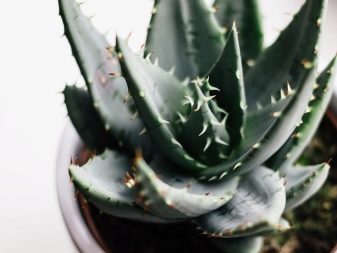

Optimal time
Since aloe is a houseplant, it can multiply at any time of the year, the main condition will be to maintain a stable temperature regime.
But experienced florists say that it is best to carry out such work in early spring... It is during this period that natural processes are activated, and rooting occurs much faster.
If you adhere to all the recommendations described above, then the reproduction of aloe will always end in success. This plant takes root well. and getting young flowers is available even for a novice grower.
How to care for a flower outdoors?
It turns out aloe vera can be grown not only at home, but also outdoors... To plant it, you must:
- Clear the prepared area from weeds and blades of grass.
- Fill the well with a nutrient mixture obtained from the following ingredients:
- sod land;
deciduous land;
- coarse sand;
- humus.
- Before planting, the roots must be dried for 3 days, and then lower the plant into the prepared substrate.
- To prevent overgrowth of weeds, you need to surround the flower with stones.
Everything must be mixed in a 2: 1: 1: 1 ratio.
Fertilizing a street plant is worth organic compounds that are used for homemade aloe vera.
How to prepare for winter?
Protecting the plant from low temperatures is especially required in regions with snowless winters, since then the risk of aloe vera freezing increases. The following natural materials are suitable for shelter:
- needles;
- spruce branches;
- high-moor peat;
- sawdust;
- fallen leaves.
You need to cover the plants at the end of October.
What to do in winter?
In winter, you need to take care of the plant especially. And although aloe vera is at rest, physiological processes still take place in it, and for their implementation, full-fledged lighting and competent hydration are required.
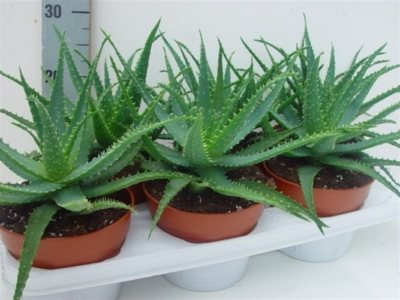

- In the morning and in the evening, you need to turn on the lamps, since the duration of daylight hours should be at least 15 hours.
- Watering in winter should be done early in the morning. It is better not to water from a watering can, otherwise the water will wash away the surface layer and will not moisten the main root. It is best to pour the liquid into the tray in which the pot is located, and from there it will gradually rise up the soil capillaries. This moisture will take 30 minutes: if the soil becomes wet at a depth of 3-5 cm during this period, then the water from the pan can be poured out.
Problems during this period: why is it drying?
Dry rot is very common in winter aloe vera. It occurs as a result of irregular watering or frequent fluctuations in humidity and temperature. It is easy to recognize this ailment - the plant begins to dry out strongly. It will no longer be possible to cure a flower from dry rot, but as a preventive measure, it is worth installing a humidifier in the room. Even with improper watering in winter, the roots can rot, therefore, for prevention, you need to use moderate moisture.
Aloe Vera is an amazing plant that is incredibly beneficial for the human body. It is used not only in medicine, but also in cosmetology. Observing all the rules for caring for flowers, growing it at home will not be difficult even for an inexperienced grower, and the plant will generously thank you with bright and lush flowering.
If you find an error, please select a piece of text and press Ctrl + Enter.
When can you divide a plant?
When the plant is "adult", you can see that it outgrows the space in the flowerpot, this indicates that it needs to be divided. It is quite simple to do this, you just need to remove the branches that appear for their further transplantation into separate flower pots. The best months to divide aloe are May, June. Since this is the period of active growing season.
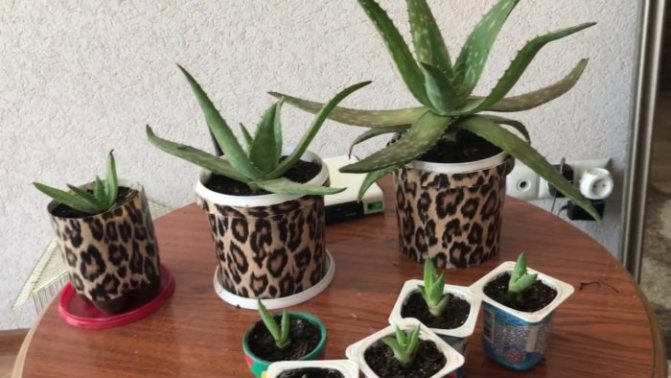

When dividing the agave, you need to remember the rules that will help not only plant it, but also preserve young shoots:
- monitor the root system. To do this, make sure that each branch has a supply of its own roots. They can be easily broken off from the stem, so you need to be careful;
- use a sharp knife. You need to separate the cuttings with a sharp tool. This will allow you to make an even cut in one motion;
- minimize damage. It is not difficult to separate succulents, the main thing is not to cut the roots or stems.
By following these rules, you can quickly divide and propagate an adult plant.
The main reasons for the transplant
Aloe is a plant that doesn't like a small pot. He gradually develops a wide root system, and a cramped pot will be deadly for her. Therefore, aloe must be transplanted into another pot correctly and on time.
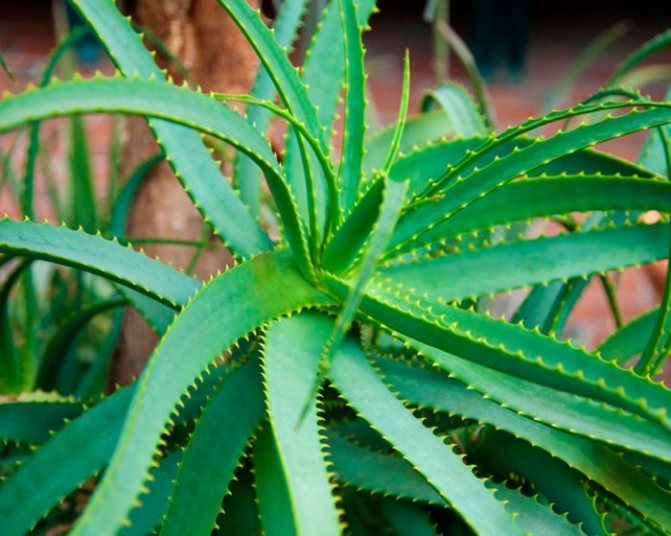

Aloe indoor
Aloe transplant is carried out for the following reasons:
- The aloe must renew itself and acquire a beautiful appearance. The decorative properties largely depend on how wide the pot it grows. In small pots, the flower will wither, its roots will rot if improperly watered.
- At times, a large number of lateral processes grow around the central bush. It is recommended to transplant it so that the processes do not take away the juices from it. The transplant rejuvenates the plant and makes it more resistant.
- The most common reason for replanting is when the pot does not fit the plant. The flower should be transplanted immediately if roots begin to creep through the drainage system.
- As the aloe grows, the soil is depleted. If there are few nutrients and trace elements in it, growth gradually slows down, the lower leaves die off. The plant gradually loses its decorative properties. Aloe will be beautiful if the soil is enriched with nutrients and valuable trace elements.
- With improper watering, the roots gradually begin to rot. In this case, the flower needs to be transplanted urgently.
When and why do you need a transplant?
Aloe is a succulent plant, which over time grows an extensive root system that does not tolerate small cramped pots. Also the transplant procedure must be carried out in the following cases:
- When roots rot, transplanting is the only way to save a dying plant.
- With an old depleted substrate, since in poor soil the plant slows down its growth, loses its leaves, and eventually dies altogether.
- With the formation of many processes around the central aloe.
- To renew the plant and acquire a decorative look.
- With the wrong substrate for aloe.
Leaf breeding
There are many methods of propagation of aloe, which differ in the length and complexity of the process. But it is the variety that allows you to choose the most acceptable way of breeding the agave. Leaf propagation is one of them. This method is usually used when it is necessary to rejuvenate an aged flower in order to give it a stimulus to develop.
You need to choose only a well-developed strong healthy leaf at least 8 cm in size. Then the actions are carried out in a certain order.
- The leaves should be cut with a clean and sharp tool from the very base of the stem. The cut should be oblique.
- Cut leaves, placed on a dry cloth (bandage, gauze, cotton napkin), should be left for 1-2 days in a dark room. The cut should dry out and be covered with a film.
- The dried cut is sprinkled with charcoal powder (activated carbon can be used).
- Next, a soil mixture is prepared from garden soil, sand and vermiculite, which is placed in a container and moistened.
- The leaves must be planted in the soil mixture, deepening them by about 3 cm.
- The container with leaves is placed in a fairly light and warm room.
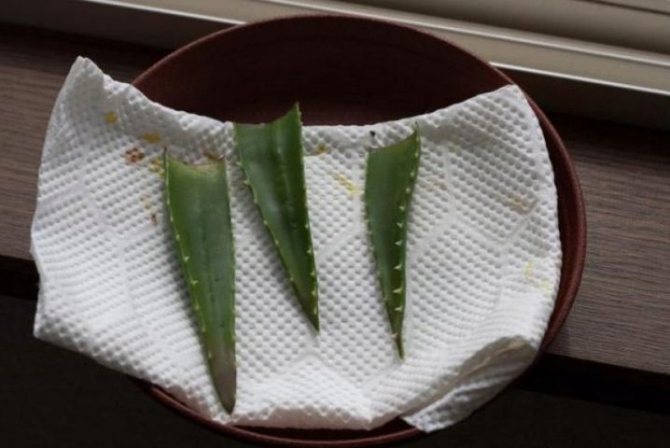

You can also not drop the leaves: they are simply laid out on the surface of the soil. The roots that appear later will themselves go into the soil. The planted leaves must be watered regularly (every day) and abundant.
After the roots appear, the leaves will begin to grow, and young seedlings can be planted in separate bowls.
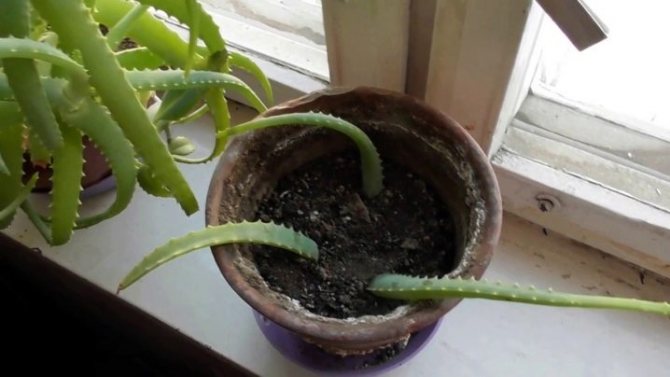

About the need for a transplant or who needs it
Aloe roots develop slowly, but transplanting cannot be delayed. There is such a thing as the removal of nutrients from the soil by a plant.The removal rate of minerals in aloe is high, which cannot be said about nitrogen, which a desert inhabitant needs little. The introduction of fertilizers will not correct the situation: the humic component of the soil is lost, enzymatic, which cannot be replenished. The soil becomes light, like dust, after watering it is taken in by a crust. Yes, and the rod-shaped root grows, and the lobules begin to bulge out of the pot. It's time to fix the situation urgently: transplant aloe, change the soil mixture.
Attention! When is aloe transplanted? Young succulents need to be transplanted annually. Starting from the fifth year - less often, with a frequency of two or three years: the process is too laborious, and even traumatic for a long-liver.
Transplant time - spring or summer. If the roots have grown insignificantly or a bulky plant is problematic to transplant, just replace a part of the land.
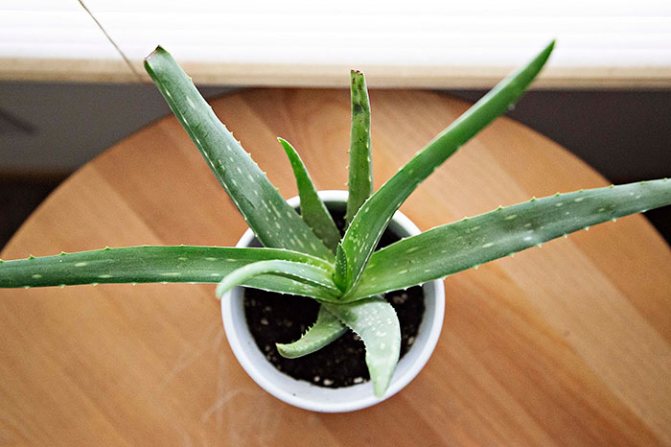

In progress: replanting correctly
When transplanting aloe, we adhere to the following simple algorithm:
- The day before the event, the soil is watered abundantly, then loosened. This will simplify the transshipment, will allow you to extract the rhizome with a clod of earth.
- Drainage is placed in a new container - 1/5 of the height of the container or 10-12 cm, then a layer of soil mixture. The pot should be half full.
- The pot is rolled over on its side in order to extract the plant together with a lump of earth. Trying to free the roots, you can not use efforts: if they are necessary, you should wet the soil again.
- Aloe roots are cleaned of lumps of old soil, not braided by roots, placed in a new container. Sprinkle on top with soil so that the root collar is buried at the same level as in the old place.
- Watering is carried out - shallow, so that the moistened soil stuck to the roots, the settled soil is poured to the initial level, carefully compacting. To slow down the drying out of the soil, after the final compaction, a layer of expanded clay or pebbles, perlite is laid on top.
- The transplanted aloe is exposed in the shade, not watered for several days, not sprayed, waiting for complete rooting.
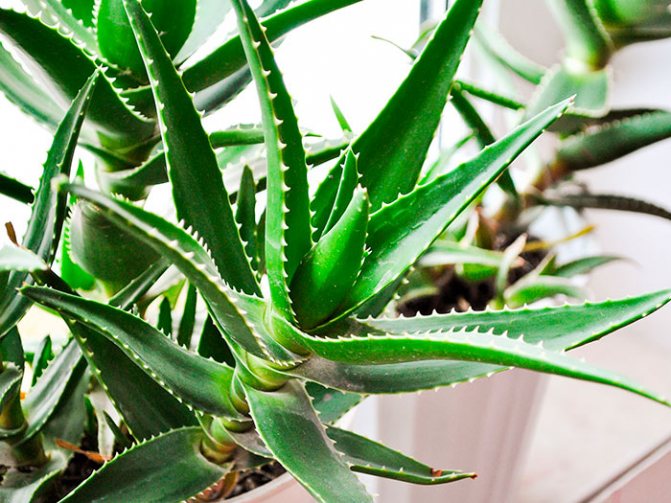

Step-by-step instructions for transplanting
It is advisable to replant a young plant at least once a year, and an adult one every two years. A transplant may be required if, during the growth process, the succulent has become cramped in the pot, as well as if the soil has become unusable and the aloe does not feel well. Regular transplantation of a healthy plant will serve as the prevention of diseases, as well as an incentive for the development of the root system.
For a transplant you will need:
- specially prepared soil;
- pot;
- gloves;
- a basin or any suitable container.
So, the aloe transplant process consists of several stages.
- We remove the plant from the pot, gently grabbing its base, turn the pot upside down over a basin of water.
- Place the aloe in the water and carefully remove the old soil from its roots.
- We fill the transplant pot with soil by about one third.
- Gently holding the plant, place it in the pot. Sprinkle evenly with soil from all sides to the leaves.
- Water and place in a shaded area for about one week.
If the plant has high-quality soil, you can skip point # 2 without removing the earthen lump.
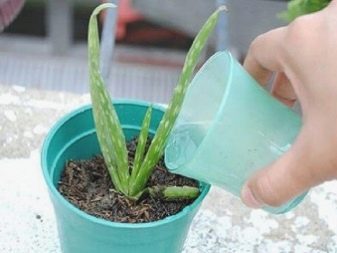

Planting material
We are used to buying the houseplants we like in a specialized store already in a pot, often already adults and blooming, but most often we find aloe from friends and relatives, in a casual conversation over a cup of tea, we learn a lot of interesting things about the properties of the plant, about who from friends and what exactly he cured with this plant - and we take a piece or a baby from the mother plant.
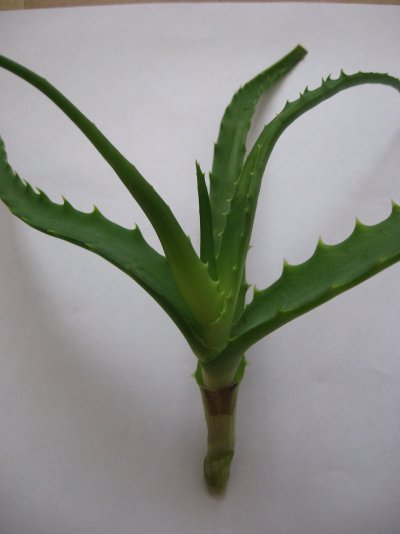

Baby
The easiest way to plant is a young plant, of which a lot grows from the mother bush at its very base. A young aloe is fully formed and its root system is already ready for independent life, but it is on the surface of the soil, as if it is waiting for a transplant into its own pot.Small plants are called babies, and planting them is the easiest and most reliable option.
Top of the stem
Part of the stem is well suited for reproduction - the top, with two or three pairs of leaves. She must have a strong, healthy appearance. It is not necessary to plant it immediately, let it lie down for 5 or 6 days, heal its wounds on its own, the places of damage should dry out. However, you can also lower the cutting into the water until the roots form. There is information about possible decay instead of root formation, but in my many years of practice this did not happen, the roots germinated, young plants lived in ordinary water for about six months, were transplanted into pots and rooted normally
Couldn't get hold of a baby or a handle? It doesn't matter, a leaf is enough, you need to pluck it as close to the mother plant as possible, the smaller the separation point, the faster the leaf will release the roots. There is no need to hurry with planting, let it lie down for a week, heal the wound, prepare for planting.
Seeds
This method of propagation of aloe is also possible, but collectors of succulents usually use it to grow decorative, variegated species. All the details about the reproduction and cultivation of aloe can be found here.
Suitable soil composition
Before transplanting aloe, you need to understand which substances will benefit it and which ones will be destructive. The main nutrients for aloe are phosphorus, potassium and calcium. With a lack of them, the leaves of the plant change color, fall off or dry out. To provide these substances, humus or wood ash is added to the soil during transplantation; you can also buy a special fertilizer for cacti and succulents. A sufficient amount of nutrients will increase the plant's hardiness, ensure the normal development of the root system and leaves.
Homemade succulents do not tolerate excess nitrogen well. The high content of this element in the soil leads to the fact that the aloe leaves crack, the plant loses its water-holding properties. Therefore, the soil should not contain peat - the main source of nitrogen for plants. The minimum amount of substance is still needed by the succulent. The amount of nitrogen in humus and wood ash is sufficient to meet this need. The acidity of the soil for aloe should be neutral or weak, the recommended pH is 6-7. The plant tolerates the lack of nutrients and moisture more easily than their excess. Therefore, resting fertilization is not required.
